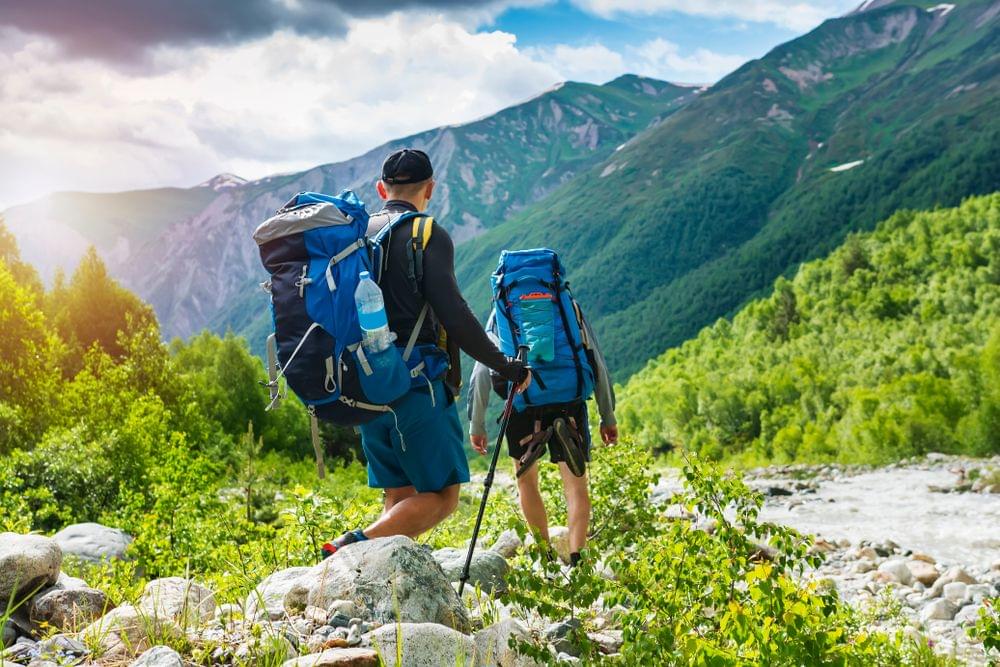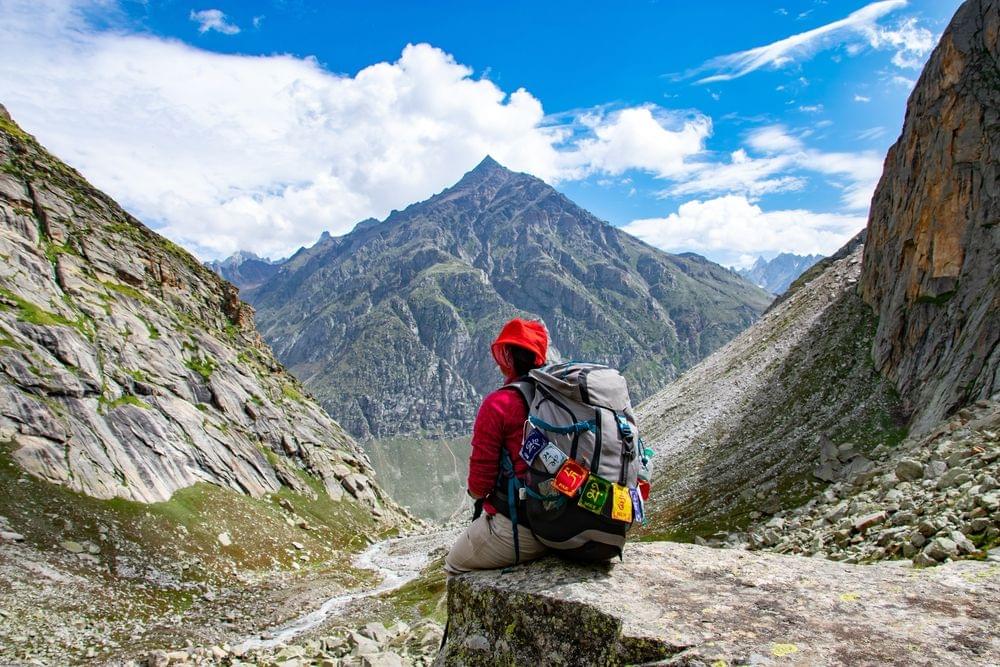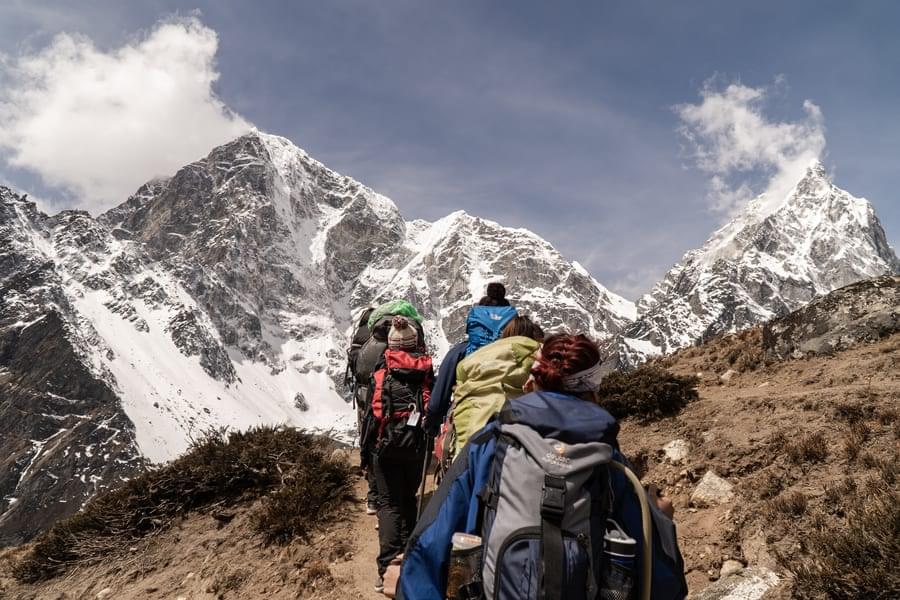Kashmir Great Lakes Trek Overview
Highlights of Kashmir Great Lakes Trek
Maximum altitude: 13,715 ft
Grade: Moderate - Difficult, Level 2
Duration: 7 days
Trekking distance: 72 kms approximately
Trail type: This is a cross over trail through a number of passes starting at Sonamarg and ending at Naranag.
Rail head: Jammu is the nearest railway station
Airport: Srinagar Airport
Snow Season: Around the month of June - July
Service from: Sonamarg to Naranag
Base camp: Sonamarg, which is a 90 kms drive from Srinagar and takes about 3 hours
Best season: During the monsoon from the beginning of July to the middle of September
Region: Jammu and Kashmir
Who can participate: The trek is open for participants between the age of 12 and 55 years and are physically fit. Participants should have experience of any high altitude trek, should be able to carry a 12-kg backpack, and must have enough stamina to cover a distance of 6 kms in 30 minutes without stress.
Kashmir Great Lakes Trek Itinerary
Srinagar to Sonmarg, Welcome to the 'Meadow of Gold'
Altitude: 7800 ft
Distance: 90 kms drive
Duration: 3 hours approx
The Kashmir Great Lakes Trek commences at Srinagar from where you will be driven to the starting point of the trek at Sonamarg.
You will depart around afternoon from Srinagar and it will take around 3 hours to reach Sonamarg.
You can spend the first day of your trek enjoying the scenic beauty of Srinagar with its lakes, gardens, and houseboats.
Walk through the Mughal Gardens or take a Shikara ride on Dal Lake.
You will spend the night at the camp site in Sonmarg.
Sonmarg to Nichnai via Shekdur, Walk beside the Overlooking Waterfalls
Altitude: 11,500 ft
Distance: 11 kms
Duration: 6 hours approx.
Day 2 trek begins right after breakfast and you embark on a trail that meanders through beautiful Kashmiri meadows, dense forests comprising trees like pine, maple, and Bhoj and offers magnificent views of the Sonamarg Valley and Thajiwas Glacier.
Your trek will be alongside the Sindh River with exceptional views of the Sonmarg Valley and picturesque streams.
After this, you will start a long trek of abot 2.5 hours through thick pine forests, right up to Shekdur.
You can stop for a short noodle and tea break here and continue your trek to Nichnai along the Nichnai Stream.
Dinner and overnight camping will be at the Nichnai Stream.
Nichnai to Vishansar Lake, The Color Changing Lake
Altitude: 12,000 ft
Distance: 13.5 kms
Duration: 6 hours
Nichnai Pass is the last point in your trek that falls under mobile coverage. From here, you have to descend to Vishansar Berry where you will stop for lunch.
The Vishansar Lake lies at a distance of just 15 minutes’ walk from the campsite, so you can visit the lake while here.
This is the first of many lakes that you will come across in the course of your trek and also one of the most stunning.
If the lake is not frozen, you can also go fishing here with permission from the Srinagar Fishing Department.
From here the trek will take a steep descent up to a scenic meadow of colorful flowers.
Vishansar to Gadsar, The Mysterious Lake of Demon
Altitude: 13,800 ft
Distance: 16 kms
Duration: 5 hours
Wake up to the sight of the Kishansar Peak with its reflection on the clear waters of the lake below.
The trek commences by the lakeside all the way up to the Kishansar Peak around 500ft above the campsite.
The trek will comprise of both easy and difficult stretches. Once you reach the Kishansar Lake and finally to the Gadsar Pass that is situated at a height of 13,800ft and is the highest point of this trek.
You will cross scenic meadows and lakes including the famous Yamsar Lake.
Start your descent after crossing Iris, and reach Gadsar Lake.
Once here, you will have to report to the nearest Army Camp where you will have to provide the necessary documents and complete all formalities to pass Gadsar.
Gadsar to Satsar, Cross the First Glacier of your trek
Altitude: 12,000 ft
Distance: 11.3 kms
Duration: 6 hours approx.
The trek starts early the next morning and you start off on a trail that will take you from the army camp towards the stream crossing a variety of terrains including terrains from super steep, flat, and even land.
After a short break at Maengandob you will head towards the first of Satsar lakes, a group of seven different lakes.
The campsite can be reached in about 2 hours from Gadsar Lake.
Another army check post lies just before the campsite where your id proofs will again have to be shared.
Satsar to Gangabal Twin Lakes, The Serene Nature's Delight
Altitude: 11,500 ft
Distance: 9 kms
Duration: 6 hours approx.
This leg of the trail is particularly spectacular around the months of July through August when the flowers are in full bloom.
Yet another army check post lies en route where IDs will be checked again followed by two small lakes that you will come across before reaching the Satsar Twin Lakes.
You will reach the twin lakes around afternoon when you can admire the beauty of the lakes that lie between the middle of the mountain.
With rock and boulder-ridden terrain, this is a test of physical and mental acumen as you pass the last of the Satsar lakes, and start hiking downwards for half an hour till you reach the forest line.
From here you will climb upwards to an altitude of 13,400ft till the summit. Witness the wonderful Gangabal and Nundkol lakes also popular for trout fishing.
Head towards the Nundkol Lake and after trekking about 20 minutes from here, you will reach the next campsite at Gangabal Lake for dinner and overnight stay.
Gangabal to Naranag | Descend with the Traditional Nomadic Hamlets
Altitude: 7,500 ft
Distance: 13 kms
Duration: 6 hours approx
This is the final day of your Kashmir Great Lakes Trek that commences from the Gangabal camp, and takes you through a grassy stretch dotted with yellow flowers and pine forests.
Start a downward descent to reach Naranag which is the last leg of your trek.
After reaching Naranag Village in Ganderbal District you can also go exploring the village and the famous Naranag Temple until you are driven back to Srinagar.
What to Pack for KGL Trek
Documents:Government photo identity card: Bring any identity proof in its original as well as photocopied form, this can either be your Aadhar card or passport. It will be required by the forest department for your identification.
Disclaimer certificate: You have to download the PDF, read it carefully and sign it. It is a legal requirement and needs to be handed over to your Trek Leader during the registration at the base camp.
Medical certificate: You need to take care of two individual parts of this, one of which must be filled by a practicing doctor and the other must be filled by you. Without this certificate, you will not be issued permission to trek by the forest department.
Other Essentials:
- Sturdy trekking shoes with good grip, ankle support, and ability to handle snow.
- A 50 to 60-liter backpack with good hip and shoulder support, and quick access pockets.
- Clothes should include 3 t-shirts and 3 insulation layers, an outer layer, and 2 trek pants.
- Sunglasses with UV protection to prevent snow blindness.
- Synthetic hand gloves with waterproofing on the outside and a padded lining on the inside.
- Sun cap to prevent headaches, sunstrokes, and quick dehydration.
- Woolen cap that will cover your ears.
- 3 pairs of socks including 2 pairs sports and 1 pair woolen socks.
- Trekking poles for balance and stability.
- Headlamp to leave your hands free.
- Rainwear such as a poncho or a rain jacket.
- Rain cover for backpack.
- Daypack with rainwear, water bottles, headlamp, medical essentials, a warm layer, and snacks.
- Cutlery with a lunch box, a mug, and a spoon.
- Toilet kit with basics such as toothbrush, toothpaste, a small moisturizer, lip balm, small soap, toilet tissue roll, and a roll-on deodorant.
- 3 or 4 plastic covers.
- Medical kit.
Know Before You Go to KGL Trek
- If you are planning to spend the night at Srinagar, stay in touristy areas like Dal Lake or Lal Chowk.
- Tourist spaces are more protected and safer than downtown areas, so try to avoid such places. This will also keep you safe during times of unrest.
- Try to merge in with the crowds by dressing and behaving like a local.
- In case a curfew is imposed, keep indoors, wait for it to pass, and do not panic.
- Consistently jog for 5 km and try to do it in under 32 minutes a few months prior to your trek, to prepare yourself for the long climb and steep ascents and descents.
- Go for hopping exercises and strengthen your glutes and the muscles around your knees to get comfortable with intense boulder sections and difficult terrains.
- If you feel sick or ill at ease, check your oxygen levels, rest, drink water, and go on a curative course of Diamox.
By Flight: You can reach Srinagar by air where you can stay for a day and then travel to Sonamarg. If you reach Srinagar in the morning, you can also go to Sonamarg on the same day. However, it is recommended that you stay back at Srinagar for a day to get the much-required rest as well as pack in some local sightseeing while here.
By Train/bus: You can also opt to take a train or bus to Jammu from where you can travel to Srinagar by a shared cab. If you are taking a bus to Jammu, you will get these scared cabs from either of the two gates outside Jammu ISBT. If you reach the railway station at Jammu, the share cabs from here to Srinagar will cost you approximately Rs. 700 to Rs. 1000 to cover the distance of 260 km. You can also take a train to Udhampur railway station which is 200 km away from Srinagar and takes about 6 hours to reach by bus.
From Srinagar you will be driven to the starting point of your trek on the morning of Day 1.
July to September: The best time to go on the Kashmir Great Lakes Trek is from the beginning of July to the middle of September as this is the only time of the year when the trail is not covered with snow. July to September is essentially when the monsoons hit the rest of the country and it may puzzle you why this is a good time for the trek. Unlike other places like Uttarakhand where most treks are closed during the monsoons as trails tend to get slippery and dangerous, things are different when it comes to Kashmir.
The mighty Pir Panjal range that segregates Kashmir from the rest of the subcontinent stretches almost 288 kms in length and about 40 – 50 kms in width. This creates a rain-shadow area as it curtails most of the heavy rain clouds from passing over into the Kashmir Valley. Thus, when it comes to the nature of precipitation and the vegetation in this region, it stands in sharp contrast with the rest of the country.
Thus July to September in the Kashmir Valley is the period when summer slowly transitions into autumn making it the best time to trek here. Moreover, the entire landscape of the surrounding areas becomes vibrant which makes this one of the most picturesque treks in the country.
General Trivia About KGL Trek
You will come across the Naranag Temple in the course of your Kashmir Great Lakes trek which is a famous religious and archaeological site. It was built by Lalitaditya Muktapida of the ancient Kayastha Naga Karkota Dynasty and is believed to be built in the honor of Lord Shiva. You will witness a Shivling and multiple carvings that can be linked with Lord Shiva here. You can also discern characteristics of the Aryan style of the 8th century in the place that mostly lies in ruins today.
Although not known by many, the Kishansar and Vishansar lakes are connected and the same water flows in both. Surprisingly, Vishansar means ‘The home of Vishnu’ and Kishansar translates to ‘the lake of Krishna’. Besides this, both lakes show no signs of algae formation unlike the Gadsar lake which always appears green due to the algae growth.
According to local mythology, Lord Shiva resides at the top of the Harmukh mountain, at a height of more than 16,000 feet. A local folklore states that a man once set out on a treacherous journey up the mountain to meet Shiva and after 12 years of rigorous trek, he could not meet the god but ultimately achieved nirvana.
Why to Go for Kashmir Great Lakes Trek?
FAQ's of Kashmir Great Lakes Trek
If I am a first-timer, is the Kashmir Great Lakes trek good for me?
Yes, for a first timer the Kashmir Great Lakes trek is a good start off, like it is for an experienced one. However, you should ensure that you maintain a good fitness level and are not suffering from ailments like Bronchitis, high blood pressure, asthma, TB, epilepsy, heart problem, or are on the higher BMI side. Moreover, if you have a medical history, you need to inform the team beforehand.
What is the age limit for the Kashmir Great Lakes trek?
The minimum age to go on a Kashmir Lake trek is about 12 to 15 years and the maximum age is 55 years. The maximum age however, can go higher depending upon your level of fitness.
Who will accompany the group on the KGL trek?
You will be accompanied by skilled and well qualified professionals who are equipped to handle any kind of emergency that may occur on the way. These include an experienced first-aid certified trek leader, a first-aid certified local guide, helpers, a cook, and other support staff.
Will I get a mobile network while during the KGL Trek?
There will be no network available during trekking. In Sonamarg you will get Airtel, BSNL, and Idea networks but not after that. In Kashmir, only postpaid connections work.
How can I handle extreme cold during the KGL trek?
You should layer up well during your trek and ensure that you eat full meals. Never go to sleep on an empty stomach. Use your sleeping bags in the proper way and make sure no empty space is left in it. Wear a thermal layer, full sleeves t-shirt, a fleece layer, thick jacket, and a waterproof or windproof jacket. On your lower body wear a thermal layer and hiking pants.
.png?w=auto&h=400)






